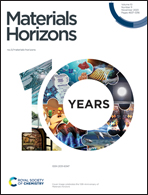Electrolessly tin-plated sulfur nanocomposite for practical lean-electrolyte lithium–sulfur cells with a high-loading sulfur cathode†
Abstract
Lithium–sulfur batteries are among the most promising low-cost, high-energy-density storage devices. The high-capacity sulfur active material undergoes electrochemical conversion between the solid and liquid states. Thus, the comprehensive design of a suitable synthesis method, substrate material, and cathode configuration is essential for developing advanced sulfur cathodes with practical cell design and cell performance parameters. Herein, an electroless plating method is employed to develop a tin-plated sulfur nanocomposite. The nanosized tin plating shell effectively encapsulates a large amount of sulfur; the nanocomposite exhibits excellent high sulfur loading and content (6–10 mg cm−2 and 65–85 wt%, respectively), and the cell based on the nanocomposite exhibits a superior low electrolyte-to-sulfur ratio of 7–4 μL mg−1. In addition to these critical cell design parameters, the tin-plated sulfur nanocomposite attains outstanding electrochemical utilization and stability for 200 cycles under a broad range of cycling rates of C/20–C/2, and additional outstanding cell performance properties in terms of a high areal capacity of 6.3–11.4 mA h cm−2, a high gravimetric capacity of 520–663 mA h g−1, a high energy density of 13–24 mW h cm−2, and a low electrolyte-to-capacity ratio of 3.75 μL mA h−1.

- This article is part of the themed collection: Celebrating 10 Years of Materials Horizons: 10th Anniversary Collection


 Please wait while we load your content...
Please wait while we load your content...